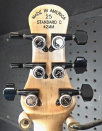Made in the USA
Neck
Wild or traditional, guitar bodies are what we notice on a guitar; that is until you pick it up. Your interface on a guitar is the neck and fret board, and if it's not good, the guitar's not good. I've built almost 2,000 guitar, bass, and banjo necks over the last 25 years and think I have my process refined in. There are four major components of a guitar neck: construction, scale, size/shape, and finish
Construction
A stable neck will have the grain oriented perpendicular to the fret board, that limits back bend and up bend. It can still flex left or right. I use book matched necks so that the grain is oriented correctly, but has opposite tension to keep the neck from twisting left or right.

Scale
Since the Tone Pod system is designed to be interchangeable, I've also taken that philosophy to necks. I have scale lengths in 24 3/4", 25", and 25 1/2", necks are interchangeable on any of the Tone Pod standard guitars. Tone Pod travel guitars have the same scales available, but use a different neck joint.
Size/shape
In addition to the information on the fret board page about width, there is also the shape of the back of the neck. Over the years, my C-shaped neck has proven the most popular. However, I also offer necks in D or V shape for no extra cost.
Finish
I have tried several finishes over the years, and my primary finish on a neck is Tru-oil, otherwise known as gunstock oil. It is hand rubbed in multiple coats, several grades of steel wool are used between coats to smooth the finish, then it is buffed out. I do occasionally use a lacquer finish to match a neck to a guitar, but overall, thin Tru-oil is more durable.



Phone: (319) 795-2631



